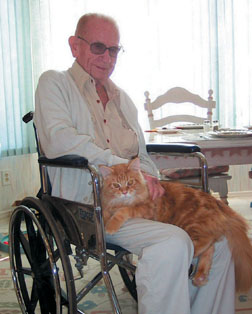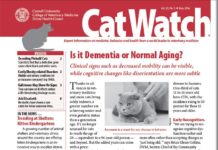No Surprise: Canine Flu Jumps Species to Cats
At last count, at least four cats at a Northwest Indiana animal shelter have tested positive for canine influenza - one of the first times the flu strain H3N2 has jumped species in the U.S. Other cats and dogs at the Humane Society Calumet Area showed similar signs of the respiratory disease, as well as lip smacking and excessive salivation, and the shelter temporarily closed.
Download the Full May 2016 Issue PDF
Advances in treatments are helping people born with congenital heart disease live longer and with greater quality of life. But not all structural problems with the heart can be permanently fixed in childhood. In fact, many treatments that help get these patients into adulthood often need revisiting later in life. Being born with congenital heart disease means being always mindful of your heart health. Some of these individuals, because they have been heart patients their whole lives, are mindful of their diet, exercise and risk factor control.
Assess That Cute Kitten Before Adoption
Come spring and fall, animal shelters across the country are flooded with newborn kittens often in need of round-the-clock care to help them survive, thrive and eventually be adopted. As adorable as shelter kittens may appear, how can you tell if theyre healthy?
Shelter Alternatives Can Save Cats’ Lives
A family member left the door open, and in a flash the cat ran outside where a dog attacked and badly injured him. His owner loved the cat but was out of work and had no money to take him to the veterinarian. She approached the shelter, sobbing, prepared to give up her cat to be euthanized. Then she met Lori Weise. "We can help you," Weise told her. "Well pay for your cat to get care." Weise is the founder of Downtown Dog Rescue (DDR), which despite its name, also helps cats. The organization helps low-income and homeless people in South Los Angeles care for and keep their pets.
Cats’ Behavior Affected Crucially Early in Life
Most of us recognize obvious signs of stress and anxiety in our cats - taking up residence under the bed being high on the list - but we may not be aware of more subtle signs, such as lowering the head and eyes, lifting a paw and staring at middle distance. These are among nearly 40 behaviors that may require intervention, according to the American Animal Hospital Associations 2015 Canine and Feline Behavior Management Guidelines, published this past summer. Behavioral problems affect more dogs and cats than any other medical condition and are one of the most common causes of euthanasia, relinquishment or abandonment of pets, the association says, adding that their management is essential in veterinary practice. It urges a culture of kindness that avoids the use of forced restraint.
Stray Cats Outnumber People in Niagara
Niagara County SPCA in upstate New York calls itself the little shelter that could. It has a small staff of 19, a surgical trailer for sterilizations and a big population problem. Despite working with rescue groups and community cat caretakers, Executive Director Amy Lewis told WGRZ-TV in Buffalo that the city has 60,000 stray and feral cats compared to 50,000 people. As long as theyre not spayed or neutered, the number of homeless cats will keep increasing, she says. A lot of people dont spay and neuter - theres not low-cost, accessible spay-neuter programs for them. We do have one at the shelter, but we dont have the resources to accommodate large numbers of animals. The no-kill shelter sterilizes 40 to 50 cats a week but needs an in-house surgical suite to do more. Its board hopes to expand the facility or build a new one.
Finding Forever Homes at End of Their Journey
The Louisiana SPCA has found a novel solution to overpopulation at its New Orleans shelter. It sends dogs and cats to partner shelters miles away, where they can often be more quickly adopted. Its service is part of a small but growing trend in U.S. shelters and rescue organizations to save animals lives and find them forever homes.
Ask Elizabeth: April 2015
I recently fostered a rescue dog I was told had eaten the feces of a feral cat while being housed in another foster home. This cat subsequently had his stool tested, and it came back positive for toxoplasma gondii. The dog unfortunately defecated in my car while I was transporting him and I am concerned that I may have been exposed to toxoplasma while cleaning up the mess in my car. Do I need to worry about this?
In The News: March 2015
Animal shelters in the U.S. take in 3.4 million cats annually and euthanize 1.3 million of them. Two shelter medicine programs have set out to save many of those lives with the launch of the Million Cat Challenge.The Koret Shelter Medicine Program at UC Davis, Maddies Shelter Medicine Program at the University of Florida and hundreds of animal shelters throughout North America want to challenge animal control facilities and private shelters to reduce euthanasia.
Theyre Giving Kittens a Chance at Life
Of all the animals in shelters, young kittens are usually the most at risk. Theyre fragile, prone to infectious illnesses and have special care needs. While some are placed in foster homes to be hand-raised until they are old enough for adoption, many shelters euthanize them as soon as they are brought in because they dont have the infrastructure or staff to care for them.
Five Reasons For The Behavior And The Techniques To Control It
Once physical and medical causes are ruled out, you may wish to consider some behavioral techniques to curb your cats excessive meowing. First, its important to determine the cause:
Ask Elizabeth: November 2014
Q. Our year-old male cat, found at a county animal shelter seven months ago, has been diagnosed with eosinophilic granuloma complex (EGC). His symptoms are incessant scratching, puffy gums, blistering mouth, swollen front paw, lameness, limping. Our veterinarian has prescribed steroids for him, and these have been somewhat helpful, but can you explain this disease so that we can better understand what is going on? …
















